Roberts A.D. The Cambridge History of Africa, Volume 7: from 1905 to 1940
Подождите немного. Документ загружается.

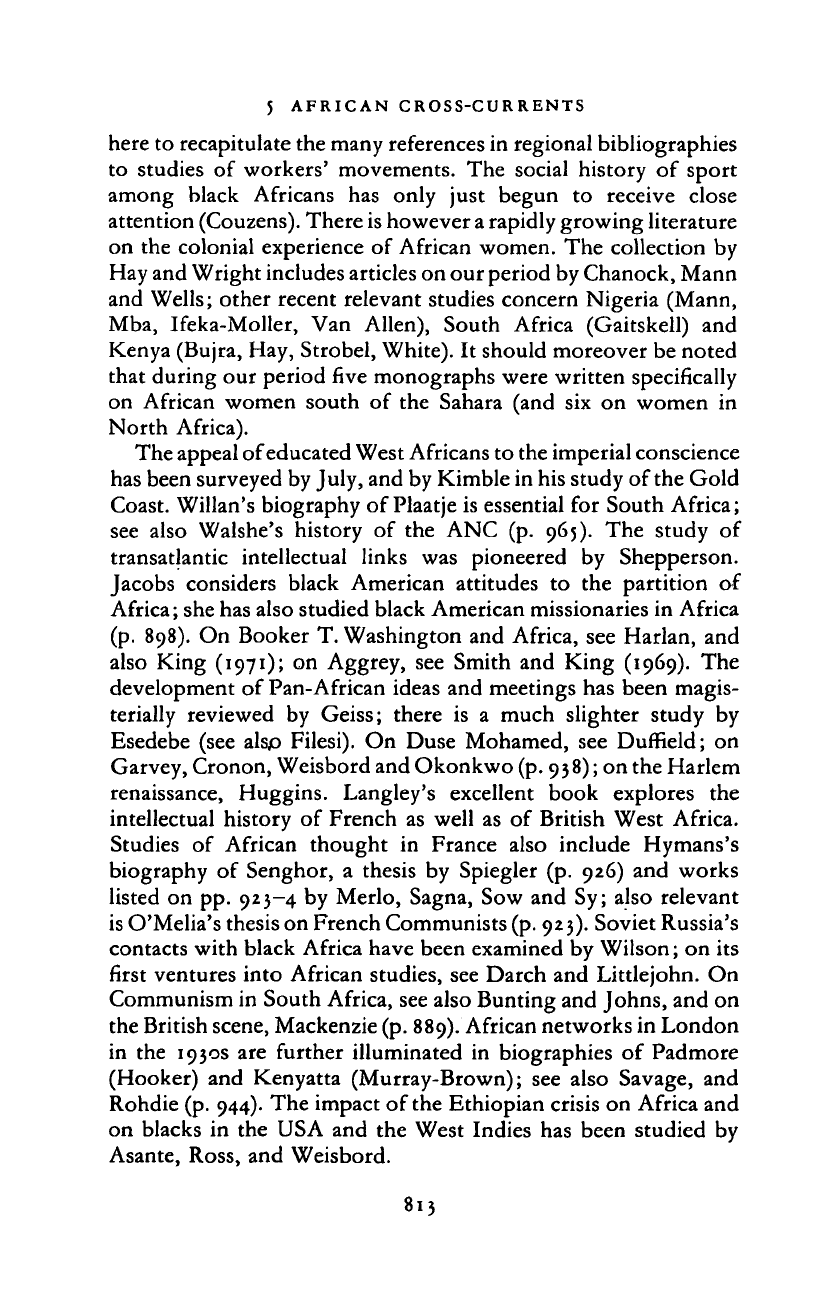
5 AFRICAN CROSS-CURRENTS
here to recapitulate the many references in regional bibliographies
to studies
of
workers' movements. The social history
of
sport
among black Africans
has
only just begun
to
receive close
attention (Couzens). There
is
however
a
rapidly growing literature
on the colonial experience of African women. The collection by
Hay and Wright includes articles on our period by Chanock, Mann
and Wells; other recent relevant studies concern Nigeria (Mann,
Mba, Ifeka-Moller, Van Allen), South Africa (Gaitskell)
and
Kenya (Bujra, Hay, Strobel, White). It should moreover be noted
that during our period five monographs were written specifically
on African women south
of
the Sahara (and six
on
women
in
North Africa).
The appeal of educated West Africans to the imperial conscience
has been surveyed by July, and by Kimble in his study of the Gold
Coast. Willan's biography of Plaatje is essential for South Africa;
see also Walshe's history
of
the ANC (p. 965). The study
of
transatlantic intellectual links
was
pioneered
by
Shepperson.
Jacobs considers black American attitudes
to the
partition
of
Africa; she has also studied black American missionaries in Africa
(p.
898). On Booker T. Washington and Africa, see Harlan, and
also King (1971);
on
Aggrey, see Smith and King (1969). The
development of Pan-African ideas and meetings has been magis-
terially reviewed
by
Geiss; there
is a
much slighter study
by
Esedebe (see alsjo Filesi). On Duse Mohamed, see Duffield;
on
Garvey, Cronon, Weisbord and Okonkwo
(p.
938); on the Harlem
renaissance, Huggins. Langley's excellent book explores
the
intellectual history
of
French as well as
of
British West Africa.
Studies
of
African thought
in
France also include Hymans's
biography
of
Senghor,
a
thesis by Spiegler (p. 926) and works
listed on pp. 923-4 by Merlo, Sagna, Sow and Sy; also relevant
is O'Melia's thesis on French Communists
(p.
923). Soviet Russia's
contacts with black Africa have been examined by Wilson; on its
first ventures into African studies, see Darch and Littlejohn. On
Communism in South Africa, see also Bunting and Johns, and on
the British scene, Mackenzie
(p.
889). African networks in London
in the 1930s are further illuminated
in
biographies
of
Padmore
(Hooker) and Kenyatta (Murray-Brown); see also Savage, and
Rohdie (p. 944). The impact of the Ethiopian crisis on Africa and
on blacks
in
the USA and the West Indies has been studied by
Asante, Ross, and Weisbord.
813
Cambridge Histories Online © Cambridge University Press, 2008

BIBLIOGRAPHICAL ESSAYS
6. THE MAGHRIB
The essential guide to both bibliographies and archives is the Arab
Islamic
bibliography,
edited
by
Grimwood-Jones
et
al. (1977).
Archival sources in the British Isles are listed by Matthews and
Wainwright. There
is a
guide by Giglio
to
the records
of
the
Italian foreign and defence ministries down
to
1922. (This
is
especially important since
in
1944
the
British destroyed
the
records
of the
governor-generalate
in
Tripoli
up to
1938.)
Pearson's Index
Islamicus
is an indispensable resource. On Islam
in North Africa, there
is
a recent annotated bibliography by Pessah
Shinar.
In
1930 bibliographies were produced by the Ministere
de la Guerre for North Africa, and by the Gouvernement-general
of Algeria. Between 1921
and
1962
a
comprehensive 'Biblio-
graphie marocaine' was published
in
Hespe'ris
and its successor
Hesperis-Tamuda.
National bibliographies of Algeria and Tunisia,
produced by their respective Bibliotheques nationales, have been
in progress since
1963
and 1969. Libya is well served by Hill (1959)
and Schliiter (1972 onwards). Books published on the whole of
North Africa have been comprehensively listed and extensively
reviewed in the
Annuaire de
I'Afrique du Nord (Aix-en-Provence,
1962—
), which has
a
special section for works in Arabic. Landau
has reviewed Soviet and East European writing
on
Morocco,
Algeria, Tunisia and Libya. An excellent critical bibliography of
French North Africa in the period of this chapter is provided by
Julien (1972), and
an
important classified list
of
works
on its
society
and
economy
by
Despois
(the
first two editions
are
especially important
for
works published during the period).
Hodges provides the most extensive bibliography of the western
Sahara. There are historiographical reviews for Algeria (Johnson)
and North Africa (Brett) in the twentieth century.
France, as the major erstwhile colonial power in North Africa,
holds most
of
the major collections
of
archival and other pri-
mary source material. The archives
of
the former government-
general
of
Algeria
are
held
in the
Archives d'Outre-mer
at
Aix-en-Provence; those
of
Tunisia
and
Morocco
are in the
Archives des Affaires Etrangeres, Quai d'Orsay. Those
of
the
ministry
of
war,
at
Vincennes, are
an
important source.
The
Bibliotheque nationale has collections
of
newspapers, official
publications
and
statistical material. Other institutions with
814
Cambridge Histories Online © Cambridge University Press, 2008
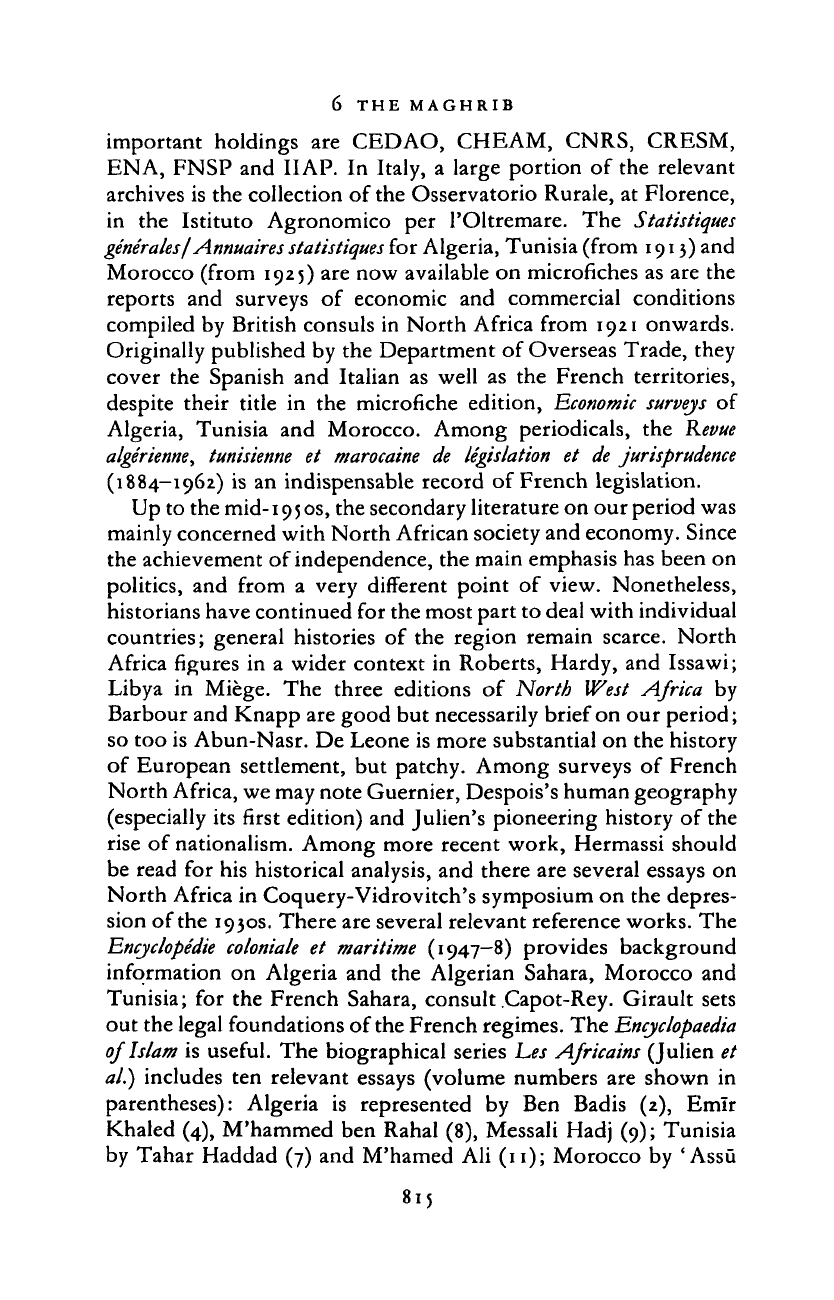
6 THE
MAGHRIB
important holdings are CEDAO, CHEAM, CNRS, CRESM,
ENA, FNSP and IIAP. In Italy, a large portion of the relevant
archives is the collection of the Osservatorio Rurale, at Florence,
in the Istituto Agronomico per l'Oltremare. The Statistiques
generales j
Annuaires statistiques
for Algeria, Tunisia (from 1913) and
Morocco (from 1925) are now available on microfiches as are the
reports and surveys of economic and commercial conditions
compiled by British consuls in North Africa from 1921 onwards.
Originally published by the Department of Overseas Trade, they
cover the Spanish and Italian as well as the French territories,
despite their title in the microfiche edition,
Economic surveys
of
Algeria, Tunisia and Morocco. Among periodicals, the Revue
alge'rienne, tunisienne et marocaine de legislation et de jurisprudence
(1884—1962) is an indispensable record of French legislation.
Up to the mid-1950s, the secondary literature on our period was
mainly concerned with North African society and economy. Since
the achievement of independence, the main emphasis has been on
politics, and from a very different point of view. Nonetheless,
historians have continued for the most part to deal with individual
countries; general histories of the region remain scarce. North
Africa figures in a wider context in Roberts, Hardy, and Issawi;
Libya in Miege. The three editions of North West Africa by
Barbour and Knapp are good but necessarily brief on our period;
so too is Abun-Nasr. De Leone is more substantial on the history
of European settlement, but patchy. Among surveys of French
North Africa, we may note Guernier, Despois's human geography
(especially its first edition) and Julien's pioneering history of the
rise of nationalism. Among more recent work, Hermassi should
be read for his historical analysis, and there are several essays on
North Africa in Coquery-Vidrovitch's symposium on the depres-
sion of the 1930s. There are several relevant reference works. The
Encyclopedie coloniale
et maritime (1947—8) provides background
information on Algeria and the Algerian Sahara, Morocco and
Tunisia; for the French Sahara, consult Capot-Rey. Girault sets
out the legal foundations of the French regimes. The
Encyclopaedia
ojIslam is useful. The biographical series Les Africains (Julien et
al.) includes ten relevant essays (volume numbers are shown in
parentheses): Algeria is represented by Ben Badis (2), Emir
Khaled (4), M'hammed ben Rahal (8), Messali Had) (9); Tunisia
by Tahar Haddad (7) and M'hamed Ali (11); Morocco by 'Assu
815
Cambridge Histories Online © Cambridge University Press, 2008
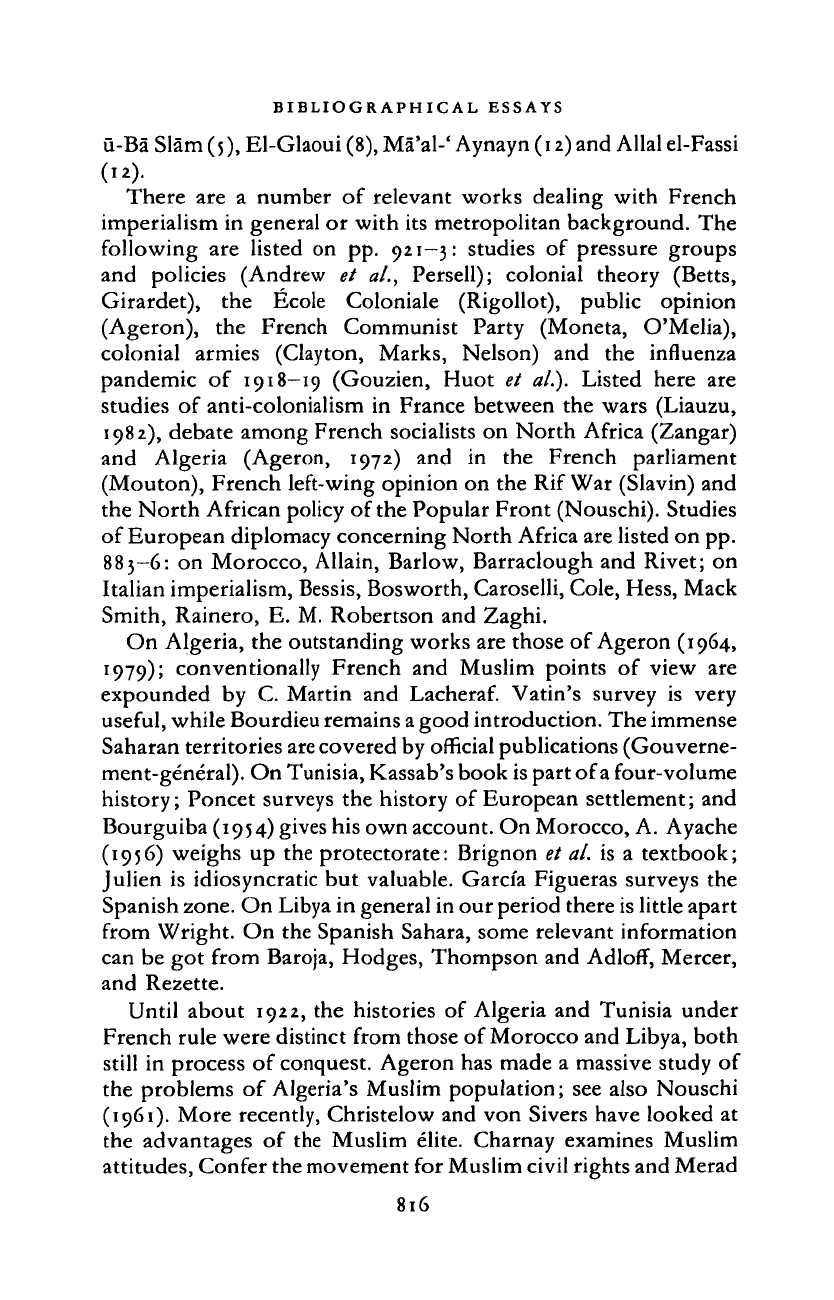
BIBLIOGRAPHICAL ESSAYS
u-Ba Slam
(5),
El-Glaoui
(8),
Ma'al-' Aynayn (12) and Allal el-Fassi
There are
a
number
of
relevant works dealing with French
imperialism in general or with its metropolitan background. The
following are listed on pp.
921-3:
studies
of
pressure groups
and policies (Andrew
et
a/., Persell); colonial theory (Betts,
Girardet),
the
Ecole Coloniale (Rigollot), public opinion
(Ageron),
the
French Communist Party (Moneta, O'Melia),
colonial armies (Clayton, Marks, Nelson)
and the
influenza
pandemic
of
1918—19 (Gouzien, Huot
et
a/.). Listed here
are
studies of anti-colonialism in France between the wars (Liauzu,
1982),
debate among French socialists on North Africa (Zangar)
and Algeria (Ageron, 1972)
and in the
French parliament
(Mouton), French left-wing opinion on the Rif War (Slavin) and
the North African policy of the Popular Front (Nouschi). Studies
of European diplomacy concerning North Africa are listed on pp.
883—6:
on Morocco, Allain, Barlow, Barraclough and Rivet; on
Italian imperialism, Bessis, Bosworth, Caroselli, Cole, Hess, Mack
Smith, Rainero, E. M. Robertson and Zaghi.
On Algeria, the outstanding works are those of Ageron (1964,
1979);
conventionally French and Muslim points
of
view
are
expounded
by
C. Martin and
Lacheraf.
Vatin's survey
is
very
useful, while Bourdieu remains
a
good introduction. The immense
Saharan territories
are
covered by official publications (Gouverne-
ment-general). On Tunisia, Kassab's book
is
part of a four-volume
history; Poncet surveys the history of European settlement; and
Bourguiba (1954) gives his own account. On Morocco, A. Ayache
(1956) weighs up the protectorate: Brignon et al. is
a
textbook;
Julien is idiosyncratic but valuable. Garcia Figueras surveys the
Spanish
zone.
On Libya in general in our period there is little apart
from Wright. On the Spanish Sahara, some relevant information
can be got from Baroja, Hodges, Thompson and
Adloff,
Mercer,
and Rezette.
Until about 1922, the histories of Algeria and Tunisia under
French rule were distinct from those of Morocco and Libya, both
still in process of conquest. Ageron has made a massive study of
the problems of Algeria's Muslim population; see also Nouschi
(1961).
More recently, Christelow and von Sivers have looked at
the advantages
of
the Muslim elite. Charnay examines Muslim
attitudes, Confer the movement for Muslim civil rights and Merad
816
Cambridge Histories Online © Cambridge University Press, 2008
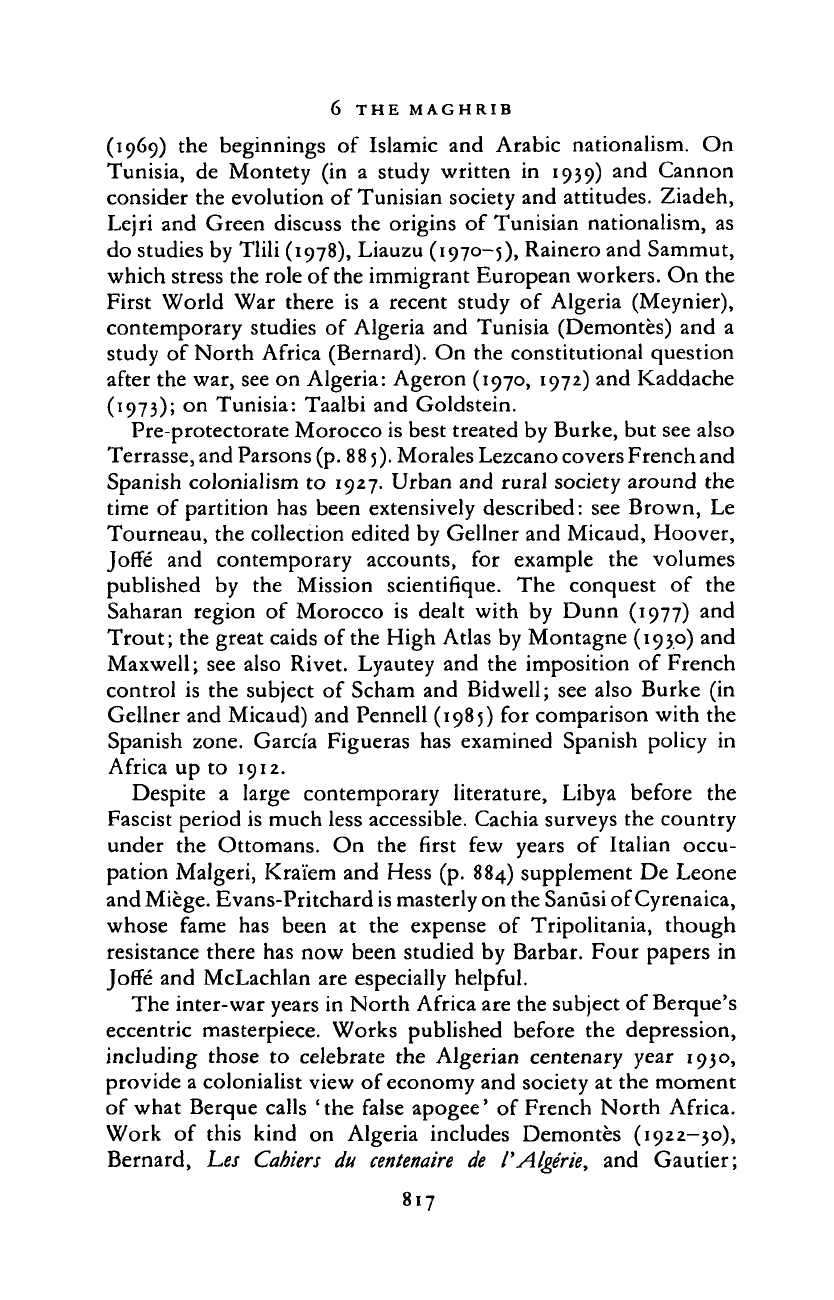
6 THE
MAGHRIB
(1969) the beginnings of Islamic and Arabic nationalism. On
Tunisia, de Montety (in a study written in 1939) and Cannon
consider the evolution of Tunisian society and attitudes. Ziadeh,
Lejri and Green discuss the origins of Tunisian nationalism, as
do studies by Tlili (1978), Liauzu (1970-5), Rainero and Sammut,
which stress the role of
the
immigrant European workers. On the
First World War there is a recent study of Algeria (Meynier),
contemporary studies of Algeria and Tunisia (Demontes) and a
study of North Africa (Bernard). On the constitutional question
after the war, see on Algeria: Ageron (1970, 1972) and Kaddache
(1973);
on Tunisia: Taalbi and Goldstein.
Pre-protectorate Morocco is best treated by Burke, but see also
Terrasse, and Parsons
(p.
8
8
5).
Morales Lezcano covers French and
Spanish colonialism to 1927. Urban and rural society around the
time of partition has been extensively described: see Brown, Le
Tourneau, the collection edited by Gellner and Micaud, Hoover,
Joffe and contemporary accounts, for example the volumes
published by the Mission scientifique. The conquest of the
Saharan region of Morocco is dealt with by Dunn (1977) and
Trout; the great caids of the High Atlas by Montagne (1930) and
Maxwell; see also Rivet. Lyautey and the imposition of French
control is the subject of Scham and Bidwell; see also Burke (in
Gellner and Micaud) and Pennell (1985) for comparison with the
Spanish zone. Garcia Figueras has examined Spanish policy in
Africa up to 1912.
Despite a large contemporary literature, Libya before the
Fascist period is much less accessible. Cachia surveys the country
under the Ottomans. On the first few years of Italian occu-
pation Malgeri, Kraiem and Hess (p. 884) supplement De Leone
and
Miege.
Evans-Pritchard
is
masterly on the Sanusi of Cyrenaica,
whose fame has been at the expense of Tripolitania, though
resistance there has now been studied by Barbar. Four papers in
Joffe and McLachlan are especially helpful.
The inter-war years in North Africa are the subject of Berque's
eccentric masterpiece. Works published before the depression,
including those to celebrate the Algerian centenary year 1930,
provide a colonialist view of economy and society at the moment
of what Berque calls 'the false apogee' of French North Africa.
Work of this kind on Algeria includes Demontes (1922—30),
Bernard, Les Cahiers du centenaire de I'Algerie, and Gautier;
817
Cambridge Histories Online © Cambridge University Press, 2008
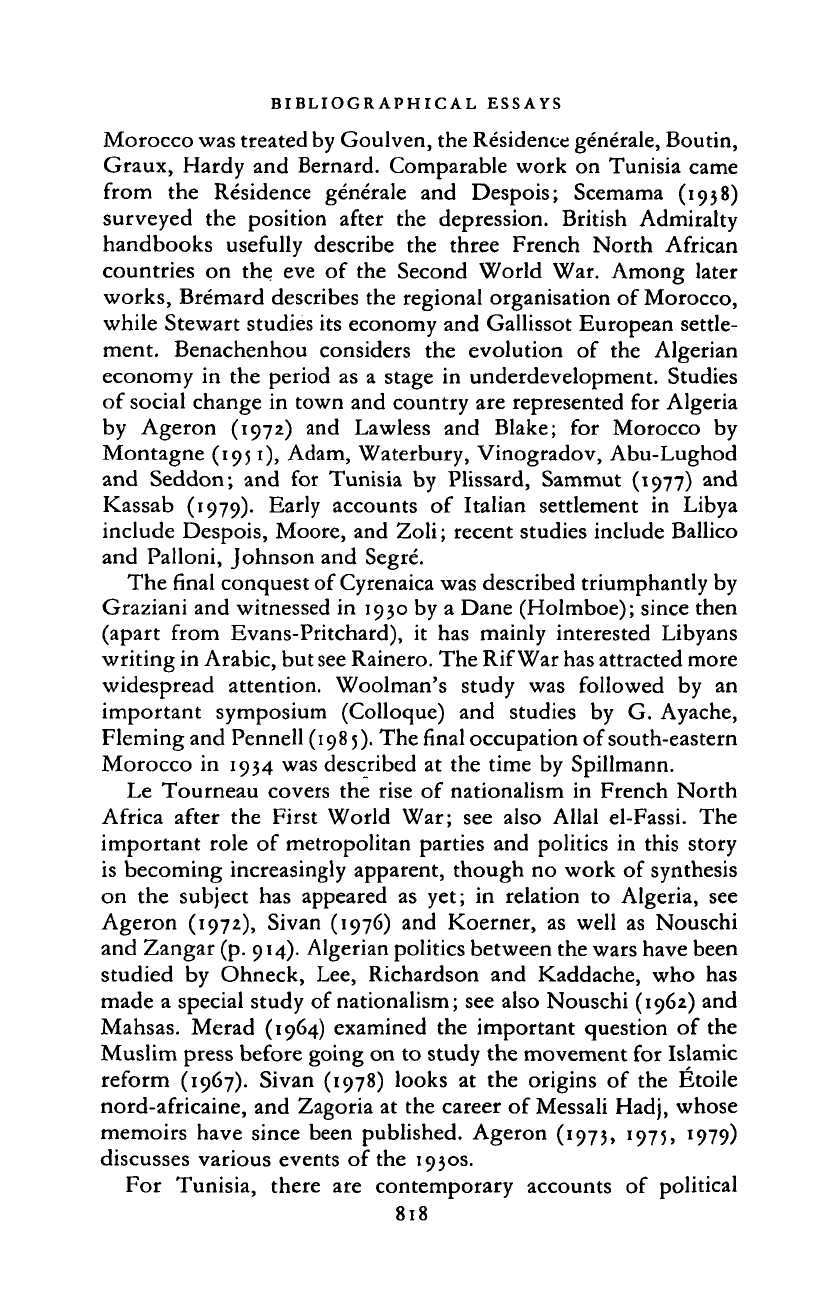
BIBLIOGRAPHICAL ESSAYS
Morocco was treated by Goulven, the Residence generale, Boutin,
Graux, Hardy and Bernard. Comparable work on Tunisia came
from
the
Residence generale
and
Despois; Scemama (1938)
surveyed
the
position after
the
depression. British Admiralty
handbooks usefully describe
the
three French North African
countries
on
the eve
of
the Second World War. Among later
works, Bremard describes the regional organisation of Morocco,
while Stewart studies its economy and Gallissot European settle-
ment. Benachenhou considers
the
evolution
of
the Algerian
economy in the period as
a
stage in underdevelopment. Studies
of social change in town and country are represented for Algeria
by Ageron (1972)
and
Lawless
and
Blake;
for
Morocco
by
Montagne (1951), Adam, Waterbury, Vinogradov, Abu-Lughod
and Seddon; and for Tunisia by Plissard, Sammut (1977) and
Kassab (1979). Early accounts
of
Italian settlement
in
Libya
include Despois, Moore, and Zoli; recent studies include Ballico
and Palloni, Johnson and Segre.
The final conquest of Cyrenaica was described triumphantly by
Graziani and witnessed in 1930 by a Dane (Holmboe); since then
(apart from Evans-Pritchard),
it
has mainly interested Libyans
writing in Arabic, but
see
Rainero. The Rif War has attracted more
widespread attention. Woolman's study was followed
by an
important symposium (Colloque)
and
studies
by
G. Ayache,
Fleming and Pennell (1985). The final occupation of south-eastern
Morocco in 1934 was described
at
the time by Spillmann.
Le Tourneau covers the rise
of
nationalism
in
French North
Africa after the First World War; see also Allal el-Fassi. The
important role
of
metropolitan parties and politics
in
this story
is becoming increasingly apparent, though no work of synthesis
on the subject has appeared
as
yet;
in
relation
to
Algeria, see
Ageron (1972), Sivan (1976) and Koerner,
as
well as Nouschi
and Zangar (p. 914). Algerian politics between the wars have been
studied
by
Ohneck, Lee, Richardson and Kaddache, who has
made a special study of nationalism; see also Nouschi (1962) and
Mahsas. Merad (1964) examined the important question
of
the
Muslim press before going on to study the movement for Islamic
reform (1967). Sivan (1978) looks
at
the origins
of
the Etoile
nord-africaine, and Zagoria at the career of Messali Had), whose
memoirs have since been published. Ageron
(1973,
1975, 1979)
discusses various events of the 1930s.
For Tunisia, there
are
contemporary accounts
of
political
818
Cambridge Histories Online © Cambridge University Press, 2008
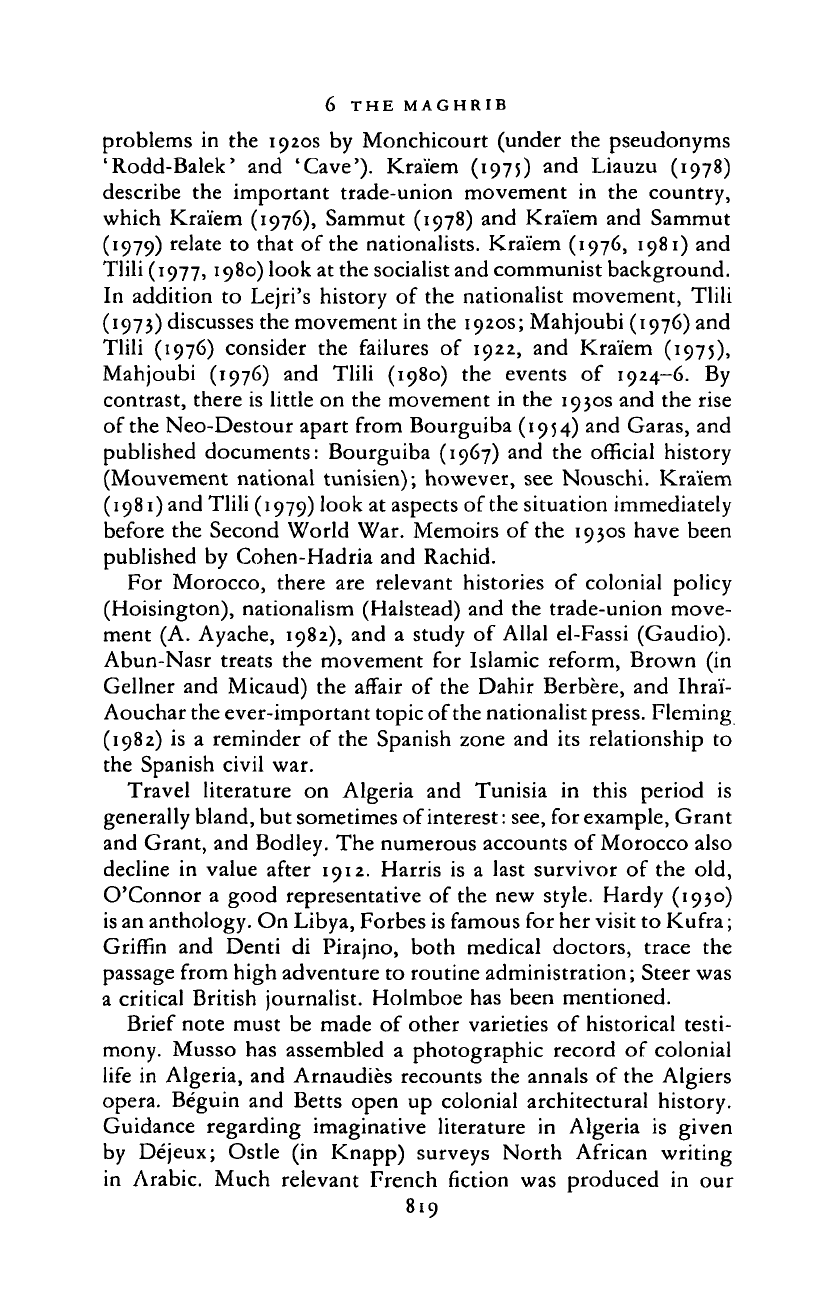
6 THE
MAGHRIB
problems in the 1920s by Monchicourt (under the pseudonyms
'Rodd-Balek' and 'Cave'). Kra'iem (1975) and Liauzu (1978)
describe the important trade-union movement in the country,
which Kraiem (1976), Sammut (1978) and Kraiem and Sammut
(1979) relate to that of the nationalists. Kraiem (1976, 1981) and
Tlili (1977, 1980) look at the socialist and communist background.
In addition to Lejri's history of the nationalist movement, Tlili
(1973) discusses the movement in the 1920s; Mahjoubi (1976) and
Tlili (1976) consider the failures of 1922, and Kraiem (1975),
Mahjoubi (1976) and Tlili (1980) the events of 1924-6. By
contrast, there is little on the movement in the 1930s and the rise
of the Neo-Destour apart from Bourguiba (1954) and Garas, and
published documents: Bourguiba (1967) and the official history
(Mouvement national tunisien); however, see Nouschi. Kraiem
(1981) and Tlili (1979) look at aspects of
the
situation immediately
before the Second World War. Memoirs of the 1930s have been
published by Cohen-Hadria and Rachid.
For Morocco, there are relevant histories of colonial policy
(Hoisington), nationalism (Halstead) and the trade-union move-
ment (A. Ayache, 1982), and a study of Allal el-Fassi (Gaudio).
Abun-Nasr treats the movement for Islamic reform, Brown (in
Gellner and Micaud) the affair of the Dahir Berbere, and Ihrai-
Aouchar the ever-important topic of the nationalist
press.
Fleming
(1982) is a reminder of the Spanish zone and its relationship to
the Spanish civil war.
Travel literature on Algeria and Tunisia in this period is
generally bland, but sometimes of interest: see, for example, Grant
and Grant, and Bodley. The numerous accounts of Morocco also
decline in value after 1912. Harris is a last survivor of the old,
O'Connor a good representative of the new style. Hardy (1930)
is
an anthology. On Libya, Forbes is famous for her visit to Kufra;
Griffin and Denti di Pirajno, both medical doctors, trace the
passage from high adventure to routine administration; Steer was
a critical British journalist. Holmboe has been mentioned.
Brief note must be made of other varieties of historical testi-
mony. Musso has assembled a photographic record of colonial
life in Algeria, and Arnaudies recounts the annals of the Algiers
opera. Beguin and Betts open up colonial architectural history.
Guidance regarding imaginative literature in Algeria is given
by Dejeux; Ostle (in Knapp) surveys North African writing
in Arabic. Much relevant French fiction was produced in our
819
Cambridge Histories Online © Cambridge University Press, 2008
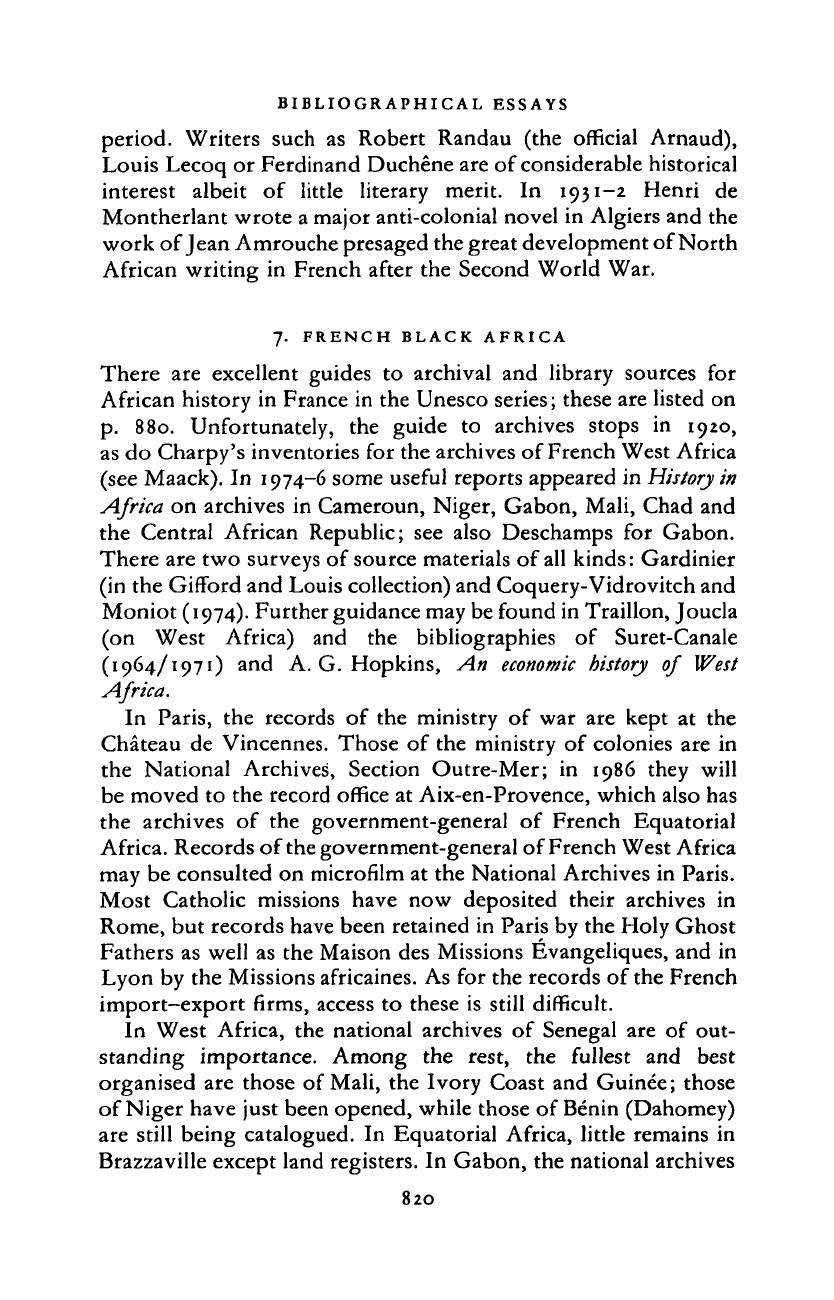
BIBLIOGRAPHICAL ESSAYS
period. Writers such
as
Robert Randau (the official Arnaud),
Louis Lecoq or Ferdinand Duchene are of considerable historical
interest albeit
of
little literary merit.
In
1931-2 Henri
de
Montherlant wrote a major anti-colonial novel in Algiers and the
work of Jean Amrouche presaged the great development of North
African writing in French after the Second World War.
7. FRENCH BLACK AFRICA
There are excellent guides
to
archival and library sources
for
African history in France in the Unesco series; these are listed on
p.
880. Unfortunately,
the
guide
to
archives stops
in
1920,
as do Charpy's inventories for the archives of French West Africa
(see Maack). In 1974-6 some useful reports appeared in
History
in
Africa on archives in Cameroun, Niger, Gabon, Mali, Chad and
the Central African Republic; see also Deschamps
for
Gabon.
There are two surveys of source materials of all kinds: Gardinier
(in the Gifford and Louis collection) and Coquery-Vidrovitch and
Moniot
(1974).
Further guidance may be found in Traillon, Joucla
(on West Africa)
and the
bibliographies
of
Suret-Canale
(1964/1971)
and
A.G.Hopkins,
An
economic
history
of
West
Africa.
In Paris, the records
of
the ministry
of
war are kept
at
the
Chateau de Vincennes. Those of the ministry of colonies are
in
the National Archives, Section Outre-Mer;
in
1986 they will
be moved to the record office at Aix-en-Provence, which also has
the archives
of
the government-general
of
French Equatorial
Africa. Records of the government-general of French West Africa
may be consulted on microfilm at the National Archives in Paris.
Most Catholic missions have now deposited their archives
in
Rome, but records have been retained in Paris by the Holy Ghost
Fathers as well as the Maison des Missions Evangeliques, and in
Lyon by the Missions africaines. As for the records of the French
import-export firms, access to these is still difficult.
In West Africa, the national archives
of
Senegal are
of
out-
standing importance. Among
the
rest,
the
fullest
and
best
organised are those of Mali, the Ivory Coast and Guinee; those
of Niger have just been opened, while those of Benin (Dahomey)
are still being catalogued.
In
Equatorial Africa, little remains in
Brazzaville except land registers. In Gabon, the national archives
820
Cambridge Histories Online © Cambridge University Press, 2008
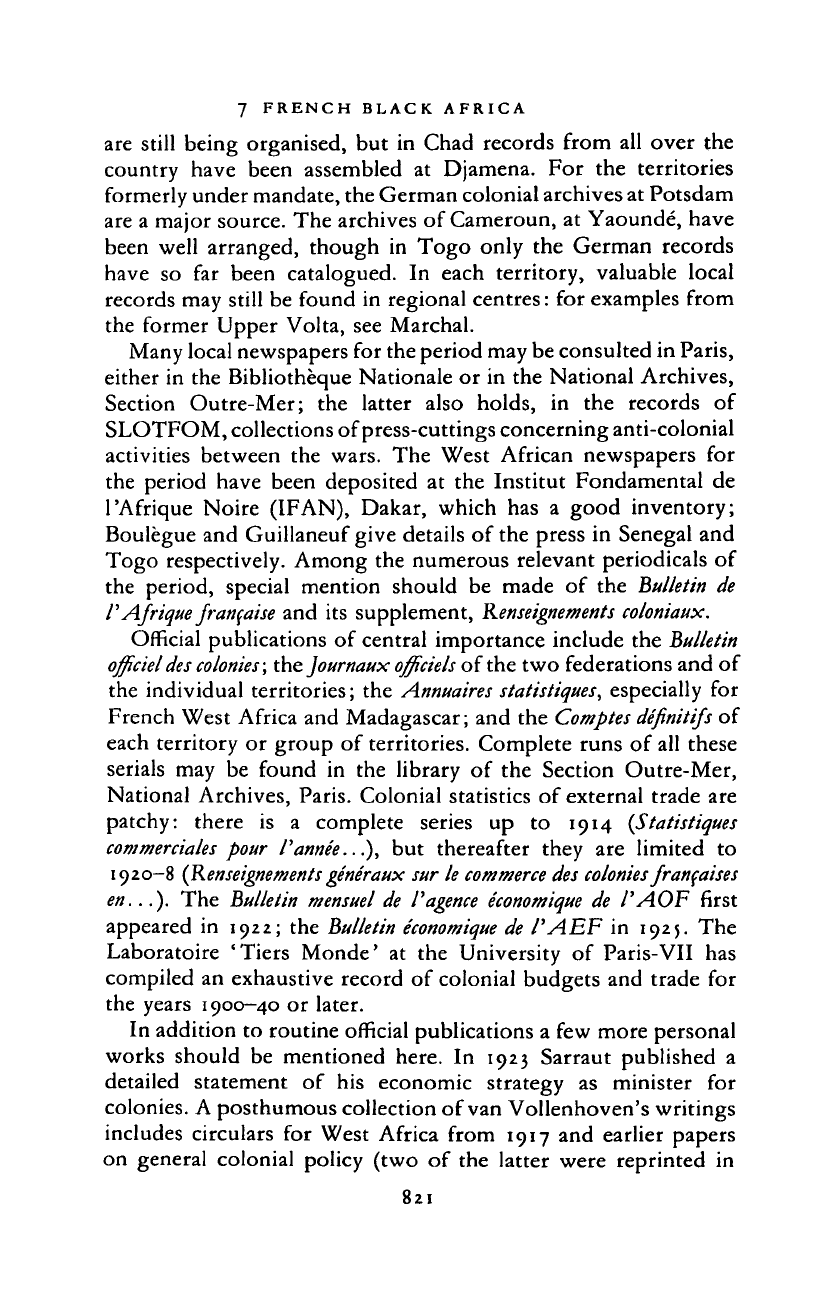
7 FRENCH BLACK AFRICA
are still being organised, but
in
Chad records from all over the
country have been assembled
at
Djamena.
For the
territories
formerly under mandate, the German colonial archives at Potsdam
are a major source. The archives of Cameroun, at Yaounde, have
been well arranged, though
in
Togo only the German records
have
so far
been catalogued.
In
each territory, valuable local
records may still be found in regional centres: for examples from
the former Upper Volta, see Marchal.
Many local newspapers for the period may be consulted in Paris,
either in the Bibliotheque Nationale or in the National Archives,
Section Outre-Mer;
the
latter also holds,
in the
records
of
SLOTFOM, collections of press-cuttings concerning anti-colonial
activities between the wars. The West African newspapers
for
the period have been deposited
at
the Institut Fondamental
de
PAfrique Noire (IFAN), Dakar, which has
a
good inventory;
Boulegue and Guillaneuf give details of the press in Senegal and
Togo respectively. Among the numerous relevant periodicals of
the period, special mention should
be
made
of
the
Bulletin
de
r' Ajrique
francaise
and its supplement,
Renseignements
coloniaux.
Official publications of central importance include the
Bulletin
officieldes
colonies;
the Journaux
officiels
of the two federations and of
the individual territories; the
Annuaires
statistiques,
especially for
French West Africa and Madagascar; and the
Comptes definitifs
of
each territory or group of territories. Complete runs of all these
serials may
be
found
in
the library
of
the Section Outre-Mer,
National Archives, Paris. Colonial statistics of external trade are
patchy: there
is a
complete series
up to
1914 (Statistiques
commetdales
pour I'anne'e...),
but
thereafter they
are
limited
to
1920-8
(Renseignementsgeneraux
sur le
commerce des
colonies jrancaises
en...).
The Bulletin mensuel de
I'agence
economique
de I'AOF first
appeared
in
1922; the
Bulletin economique de
I'AEF in 1925. The
Laboratoire 'Tiers Monde'
at the
University
of
Paris-VII
has
compiled an exhaustive record of colonial budgets and trade for
the years 1900-40 or later.
In addition to routine official publications a few more personal
works should
be
mentioned here.
In
1923 Sarraut published
a
detailed statement
of his
economic strategy
as
minister
for
colonies. A posthumous collection of van Vollenhoven's writings
includes circulars for West Africa from 1917 and earlier papers
on general colonial policy (two
of
the latter were reprinted
in
821
Cambridge Histories Online © Cambridge University Press, 2008
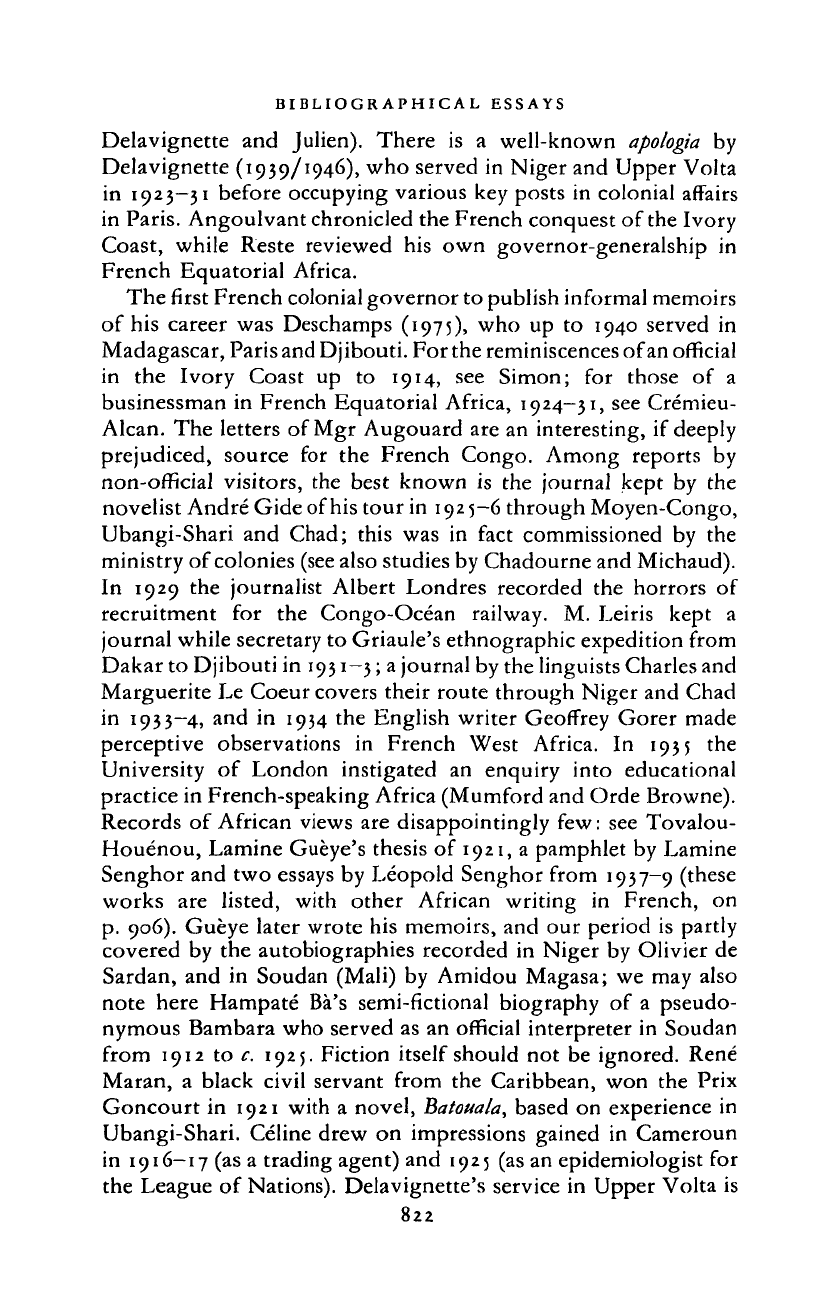
BIBLIOGRAPHICAL ESSAYS
Delavignette
and
Julien). There
is a
well-known
apologia
by
Delavignette (i939/1946), who served in Niger and Upper Volta
in 1923—31 before occupying various key posts in colonial affairs
in Paris. Angoulvant chronicled the French conquest of the Ivory
Coast, while Reste reviewed his own governor-generalship
in
French Equatorial Africa.
The first French colonial governor to publish informal memoirs
of his career was Deschamps (1975), who up
to
1940 served
in
Madagascar, Paris and Djibouti. For the reminiscences of an official
in
the
Ivory Coast
up to
1914,
see
Simon;
for
those
of a
businessman in French Equatorial Africa,
1924-31,
see Cremieu-
Alcan. The letters of Mgr Augouard are an interesting, if deeply
prejudiced, source
for
the French Congo. Among reports
by
non-official visitors, the best known
is
the journal kept by the
novelist Andre Gideof his tour in
1925—6
through Moyen-Congo,
Ubangi-Shari and Chad; this was
in
fact commissioned
by the
ministry of colonies (see also studies by Chadourne and Michaud).
In 1929 the journalist Albert Londres recorded the horrors
of
recruitment
for the
Congo-Ocean railway. M. Leiris kept
a
journal while secretary to Griaule's ethnographic expedition from
Dakar to Djibouti in
1931-3;
a
journal by the linguists Charles and
Marguerite Le Coeur covers their route through Niger and Chad
in 1933—4, and
in
1934 the English writer Geoffrey Gorer made
perceptive observations
in
French West Africa.
In
1935
the
University
of
London instigated
an
enquiry into educational
practice in French-speaking Africa (Mumford and Orde Browne).
Records of African views are disappointingly few: see Tovalou-
Houenou, Lamine Gueye's thesis of
1921,
a pamphlet by Lamine
Senghor and two essays by Leopold Senghor from 1937-9 (these
works
are
listed, with other African writing
in
French,
on
p.
906). Gueye later wrote his memoirs, and our period is partly
covered by the autobiographies recorded in Niger by Olivier de
Sardan, and in Soudan (Mali) by Amidou Magasa; we may also
note here Hampate Ba's semi-fictional biography
of a
pseudo-
nymous Bambara who served as an official interpreter in Soudan
from 1912 to c. 1925. Fiction itself should not be ignored. Rene
Maran,
a
black civil servant from the Caribbean, won the Prix
Goncourt in 1921 with
a
novel,
Batouala,
based on experience in
Ubangi-Shari. Celine drew on impressions gained
in
Cameroun
in 1916—17 (as a trading agent) and 1925 (as an epidemiologist for
the League of Nations). Delavignette's service in Upper Volta is
822
Cambridge Histories Online © Cambridge University Press, 2008
